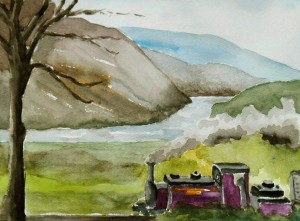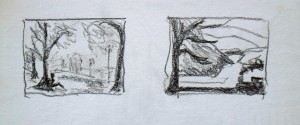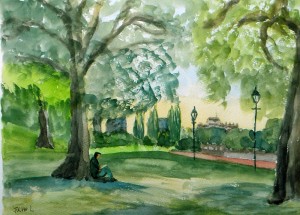Here is an explanation of how I approach a painting – Part 1.
1) Planning or Preparation – 5 Minutes Max

Choose a subject – If I’m in my ‘great big studio under the sun’ ie it’s a ‘plein air’ day I’ll spend a minute or two thinking what it is I like about this view, if I’m indoors, I’ll choose a subject for which I already have some quick sketches and perhaps some photographs, from an earlier visit. So I’m thinking about what drew me to this view, was it the way the light ‘caught’ the subject, was it just a ‘pretty picture’ or a view I’ve seen in another painting, or photograph? Once I know why I want to paint this subject, I have to consider other factors that may change the subject’s appearance as I work. So the time of day is important, How will the sun’s movement affect what I’m doing for the next hour or two, which direction is it travelling, what will happen to the colour and intensity of the light and the position of the cast shadows. What about clouds, are there any and how might they develop, its harder to predict this in advance, but I need to think where my lightest lights will be and my darkest darks, and I need to pick a point in time when I decide to fix these in my work. It’s a big mistake to try and follow the sun and the shadows as they move on their way. Am I next to a tidal river or the sea? Is the tide coming in or out? On more than one occasion I’ve found the water lapping at my feet and had to move fast, or the river has turned to mud or vice versa. If I’m in the studio I need to be sure not to just copy the photographs, because the tonal values will lead to a dull uninteresting painting and the colours likewise will be unexciting.
2) Decide on composition – 5 minutes max

I sit down, make myself comfortable, and look for the strong shapes – these are important. The bow of a boat, the shape of a building the curve of a road or pathway. What will be the focal point and what can I leave out? Many a good painting has been ruined by having too much ‘clutter’. I know its there, but that is no reason for me to include it in my work. This is where I pull out my artists licence, metaphorically speaking, My most interesting shape, may be a curved footpath, which leads my eye in towards my chosen focal point. Looking around, I also notice an ugly old building, dominating another part of the scene, which is in conflict with my focal point. If it doesn’t add interest to my subject, then I can decide to leave it out. There may be a tree right in the centre of my view, so what’s stopping me moving it to one side, where it could be used to good effect to frame the painting and to prevent the viewers eye from wandering off, out of the picture. My aim is to create a route along which the viewers eye will travel, across and up and down the painting, until they rest at the focal point. The longer I can hold their interest, the more successful it will be.
3) Tonal and initial sketches – 5 Minutes Max.
In my sketchbook, I draw a rectangle about 3″ x 2″ and quickly put in the big dark shapes, then the mid tones, and leave the highlights blank, (see above). For the most powerful effect, brightest lights go against darkest darks and vice versa, by squinting, I can determine what goes where. If my plan doesn’t work, I can do another, and darken a highlight or lighten a dark, remember that artistic licence! This is the time to make changes, before water meets the paper. When happy with this sketch, I’ll lightly draw the big shapes in position on my watercolour paper. I’m now ready to paint and its only taken me 15 minutes Max.

Because of this preparation, I know exactly how and what I’m going to do, and furthermore, when the finished painting is eventually exhibited, the viewer will see the full range of tonal values, and their eye will be led unknowingly but deliberately, into the painting, and around it on a journey, until it settles on the focal point. They may or may not understand why, but my hope is that they will know that this painting works, it has some attraction, even better if it has made an ’emotional connection’.
That is important to an artist.
